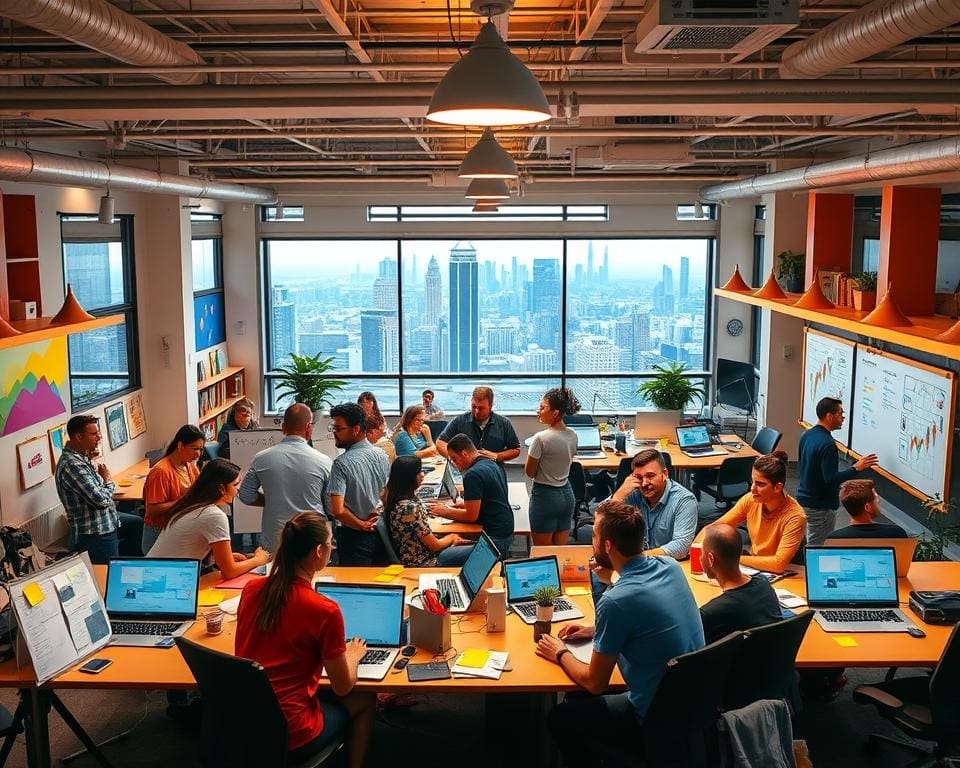In the dynamic realm of creativity, understanding how to motivate creative teams is essential for harnessing their fullest potential. Creative professionals often grapple with fluctuating moods and the unpredictable nature of their outputs, which can pose unique challenges. However, fostering a motivated team can significantly enhance productivity and innovation, driving superior results for organisations. Research consistently indicates that motivated teams exhibit higher engagement levels, leading to greater satisfaction and reduced turnover rates. By implementing effective motivation strategies, leaders can cultivate a vibrant atmosphere rich in inspiration in the workplace, ultimately paving the way for exceptional achievements.
The Importance of Motivation in Creative Teams
Motivation is the backbone of successful creative teams, influencing their overall productivity and innovation. Understanding the creative process involves recognising that it consists of varying cycles of inspiration, development, and sometimes frustration. This nuanced awareness aids in grasping the motivation significance within these teams, as it often determines the quality and impact of the final output.
Understanding the Creative Process
The creative process is rarely linear; it oscillates between productive and stagnant phases. Embracing this reality allows for better management of outputs. Recognising this cycle fosters an environment where team members feel comfortable expressing ideas, even when faced with blocks. Acknowledging these dynamics enhances individual and collective focus, steering energy towards achieving common goals.
Why Motivation Matters
Intrinsic motivation serves as a driving force, often leading to remarkable outcomes. Research has shown that individuals motivated by passion and purpose produce higher quality work. Engaging with motivational theories, such as Maslow’s hierarchy of needs, reveals the profound connections between fulfilling psychological needs and boosting creativity. Prioritising motivation in creative team dynamics not only enhances satisfaction but also cultivates an environment ripe for innovation.
What’s the best way to motivate creative teams?
Motivating creative teams requires an understanding of specific factors that stimulate creativity and drive performance. Identifying these motivational factors can lead to improved employee engagement and a more vibrant work atmosphere.
Identifying Key Motivational Factors
Creative professionals often thrive on autonomy, mastery, and purpose, constituting essential motivational factors. A survey of creative teams may reveal that:
- Autonomy fosters a sense of ownership over projects.
- Mastery allows individuals to hone their skills, leading to greater satisfaction.
- Purpose inspires individuals to connect their work with broader organisational goals.
Incorporating these elements into employee engagement strategies can significantly enhance motivation within the team. Understanding which factors resonate most with team members is essential for crafting tailored approaches.
Tailoring Approaches to Individual Needs
Recognising that each team member has unique motivational drivers is vital for cultivating personalised motivation. Engaging in one-on-one discussions and organising workshops can provide insights into individual preferences and desires. This personalised approach not only elevates motivation but also creates a stronger bond among team members.
By acknowledging these differences and implementing targeted strategies, organisations can ensure that their creative teams remain inspired and productive.
Creating a Supportive Work Environment
A supportive work environment plays a pivotal role in nurturing creativity among team members. By designing a workspace that promotes collaboration and inspiration, organisations can unlock the full potential of their creative teams. This section highlights the importance of both physical space and workplace culture in fostering motivation and innovation.
Physical Space and Resources
A creative physical space should offer versatility to accommodate various work styles. Elements such as open areas for brainstorming, quiet zones for focused tasks, and comfortable lounges foster an atmosphere conducive to creativity. Providing suitable resources, including advanced technology and tools, enhances the team’s ability to execute their ideas effectively. Such a well-thought-out physical environment communicates to employees that their creativity is valued and supported.
Cultivating a Positive Culture
A healthy workplace culture invites open feedback and encourages team members to share ideas freely. Establishing norms that promote psychological safety allows individuals to take creative risks without the fear of negative repercussions. This culture of support not only motivates employees but also strengthens their emotional connection to the organisation. When individuals feel secure in their contributions, innovation flourishes, propelling the organisation forward.
Encouraging Collaboration and Teamwork
Collaboration serves as the backbone of creative teams, allowing diverse ideas to flourish. Trust-building in teams plays a crucial role in creating an environment where team members feel comfortable sharing their thoughts openly. When individuals believe in their colleagues, creative synergy emerges, fostering innovative solutions that might otherwise remain undiscovered. This section will delve into the steps necessary for establishing trust and maximising the potential of effective brainstorming.
Building Trust Among Team Members
Trust-building in teams is essential for cultivating an atmosphere of collaboration. Engaging in activities that promote transparency and vulnerability can significantly enhance team dynamics. By participating in exercises that require honest communication, team members forge deeper connections. This not only strengthens relationships but also boosts overall morale. Options for trust-building activities include:
- Team retreats focused on personal sharing and team goals
- Regular feedback sessions to voice thoughts on team operations
- Icebreaker games that encourage openness and laughter
Utilising Brainstorming Sessions Effectively
Effective brainstorming serves as a vital tool for harnessing the full potential of team collaboration. To ensure that these sessions yield fruitful results, establishing a clear structure can be beneficial. Consider the following strategies for maximising productivity during brainstorming:
- Set specific objectives for each session to channel focus
- Create an inclusive environment that values every input
- Encourage team members to build on each other’s ideas instead of dismissing them
These methods will not only enhance the quality of ideas generated but also foster a sense of belonging. A unified team that trusts each other generates creativity that leads to exceptional outcomes.
Recognising and Celebrating Achievements
Acknowledging the contributions of team members plays a crucial role in fostering a positive workplace. Recognition in the workplace is not simply a nice gesture; it significantly enhances morale and cultivates a culture of appreciation. This type of environment can lead to increased motivation through feedback, encouraging individuals to excel in their roles.
Importance of Acknowledgement
Celebrating achievements, no matter how big or small, reinforces desired behaviours and encourages teams to work towards common goals. Regularly recognising contributions helps individuals feel valued, which in turn fosters loyalty and engagement. This essential practice is a key driver of productivity, resulting in a motivated and high-performing team.
Methods of Recognition
There are numerous effective methods for recognising achievements within a team. Some popular approaches include:
- Awards for outstanding performance
- Shout-outs during team meetings to highlight specific contributions
- Peer recognition platforms that allow team members to commend each other
- Celebratory events for reaching major milestones
By implementing a variety of recognition strategies, organisations can create a supportive atmosphere that not only appreciates individual contributions but also amplifies motivation overall. Celebrating achievements transforms the workplace into an inspiring environment filled with driven and enthusiastic team members.
Providing Opportunities for Professional Development
Investing in professional development is essential for fostering a motivated and innovative creative team. Through structured programmes like employee training sessions and workshops, organisations equip their workforce with valuable skills and insights. These opportunities not only enhance individual capabilities but also contribute significantly to the team’s overall success.
Training and Workshops
Regular employee training can take various forms, from in-house seminars to specialised courses led by industry experts. Workshops focus on practical skill-building, encouraging participants to apply their newfound knowledge in real-world scenarios. This approach boosts confidence and inspires creativity, leading to enhanced outputs.
Mentorship and Coaching
Mentorship programs play a crucial role in personal and professional growth. By pairing less experienced team members with seasoned professionals, organisations create a supportive environment. Mentors provide tailored advice, helping mentees navigate their career paths effectively. This relationship not only strengthens individual skillsets but also cultivates deeper connections within the team.
Incorporating Flexibility and Autonomy
Fostering an environment that prioritises flexibility and autonomy can significantly enhance motivation within creative teams. Flexible working arrangements allow employees to choose their schedules, leading to better mental health and increased creativity. This approach encourages team members to take ownership of their work, which can, in turn, drive productivity and satisfaction.
The Benefits of Flexible Working Hours
Flexible working offers numerous advantages that can greatly benefit creative teams. Some key benefits include:
- Improved work-life balance, allowing team members to manage personal and professional commitments more effectively.
- Enhanced creativity as employees work during their peak productivity hours.
- A reduction in stress levels due to the elimination of rigid schedules.
Empowering Team Members
Empowering team members is crucial for cultivating a motivated workforce. When employees have the freedom to make decisions concerning their projects, they experience a greater sense of ownership. This autonomy in the workplace inspires innovation and can lead to:
- Increased engagement with their tasks, as individuals feel more responsible for outcomes.
- A stronger commitment to the team’s goals, resulting from their active involvement in decision-making.
- Heightened creative empowerment, enabling unique ideas to flourish.
Utilising Technology to Enhance Motivation
In today’s fast-paced digital landscape, leveraging technology in teamwork has become paramount for motivating creative teams. Various motivation tools have emerged, enabling organisations to foster collaboration and enhance communication. Project management software, such as Trello or Asana, allows teams to streamline their workflow and keep track of their progress, making tasks transparent and facilitating motivation through accountability.
Emerging technologies like virtual reality and gamification strategies offer innovative ways to engage teams and spark creativity. By integrating gamified elements into tasks, team members can enjoy a sense of achievement, encouraging a continuous cycle of motivation. This not only enhances creative processes but also contributes to a culture of collaboration where innovative ideas thrive.
Ultimately, adapting to these technological advancements not only provides essential resources for a motivated workforce but also helps teams remain inspired and engaged. By investing in tools that promote seamless interaction and creative thinking, organisations position themselves to unleash the full potential of their creative teams, leading to extraordinary outcomes.









